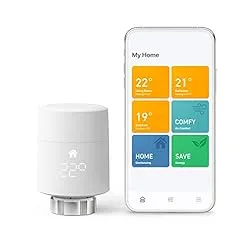What is a Smart Radiator Valve? How Do They Work?
If you’re thinking about investing in a smart heating system, you’ll probably come across smart radiator valves. But, what are they and how do they work with smart thermostats? Keep reading to find out.
What is a Smart Radiator Valve?
Traditionally, radiators will have a thermostatic radiator valve (TRV) that needs to be set manually. This controls the flow of water in and out of the radiator and consequently impacts the temperature.
Once you have found the temperature you like, you would normally leave it alone and use the central heating system to control temperature.
This means that you heat rooms that may not need to be heated and you cannot control the temperature of individual rooms. As smart heating systems improve, there are now options to control temperature zones thanks to smart radiator valves.
Why Do I Need a Smart Radiator Valve?
With the help of a smart radiator valve, you can remotely control the radiator without leaving the sofa. All you need is a WiFi connection through which the temperature of the radiator can be controlled, preferably using a smartphone app.
This is helpful for two reasons:
1. Shared Heating
A lot of residential buildings and dwellings have shared heating systems, which help save money on electricity bills, maintenance and convenience, amongst other things.
One catch is that the heating levels cannot be altered from your end. It is centrally set up and managed by the person in charge of the system.
This is where smart radiator valves come in. Install one of these and regulate the heating for your residential space, irrespective of the temperatures set up centrally.
2. Zoning (room-by-room heating)
Even if you have a central radiator installed for the house, which provides heating to all the rooms, you can create a multi-zone heating environment. Smart radiator valves can help set up different temperatures in different parts of the house.
Creating different zones means that some spaces of the residence will only be heated when required. Let’s not forget the savings on electricity and the conquest bills that it will have.
How Do Smart Radiator Valves Work?
Virtually every smart radiator valve relies on the two integrated temperature sensors to gauge the room temperature.
One sensor measures the outflowing air’s temperature against the setpoint temperature of the room through the second sensor.
For the purpose of communicating with the user, the smart valve uses the long-range frequency to communicate via the WiFi, which is connected to the Internet.
And the communication reaches the smartphone, as provided by the manufacturer of the smart radiator valves. Together with the app, you can control the radiator from your smartphone itself. Set temperatures, tailored schedules, timers, and more.
What’s the Best Smart Radiator Valve?
If you’re just getting started with smart radiator valves, I recommend you take a look at the Tado starter pack.
The valves are very affordable and can easily be fitted on top of existing radiator valves.
The Tado app is very advanced with features such as open window detection and geofencing to detect when whether anyone is home.
The starter kit includes both a thermostat and a radiator valve, if you wish to expand the kit you will need one thermostat per room and one radiator valve per radiator.
Find out more in my full guide to the best smart TRV starter kits.

Do Smart Radiator Valves Need To Be Installed Professionally?
No, most smart radiator valves, including the Tado recommended above, can be retrofitted on top of your existing radiator valves.
This can be done by following the instructions provided and doesn’t require a professional installer.